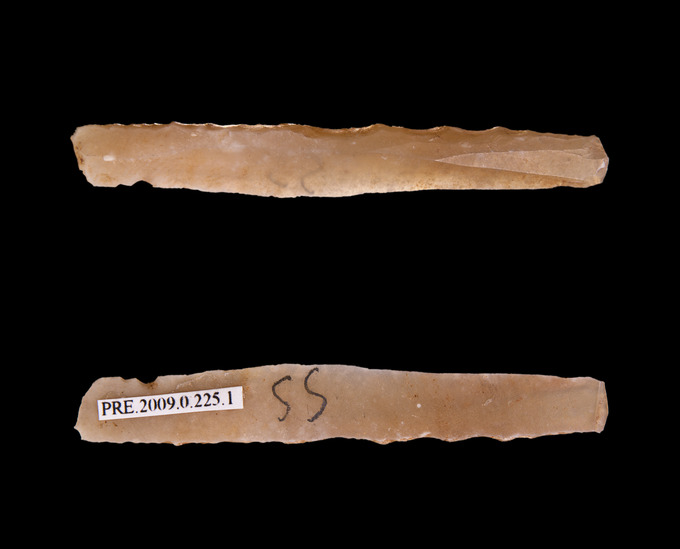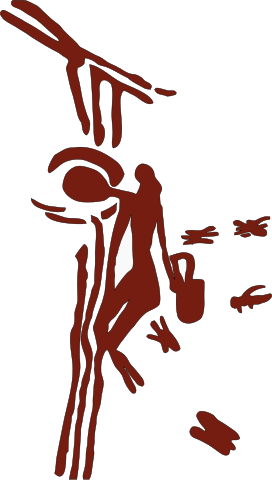2.3: The Mesolithic Period
- Page ID
- 52983
Mesolithic Art
During the Mesolithic period, humans developed cave paintings, engravings, and ceramics to reflect their daily lives.
Learning Objectives
Compare and contrast the Mesolithic period with the Paleolithic and Neolithic periods
Key Takeaways
Key Points
- The Mesolithic or Middle Stone Age is an archaeological term used to describe specific cultures that fall between the Paleolithic and the Neolithic Periods.
- The use of small chipped stone tools called microliths and retouched bladelets are the key factor to identify the Mesolithic as a prehistoric period.
- Mesolithic people likely continued the art forms developed during the Upper Paleolithic Period, including cave paintings and engravings , small sculptural artifacts , and early megalithic architecture.
- The most extensive collection of Mesolithic rock art has been found on the Mediterranean coast of Spain. These paintings consist of human and animal figures in scenes of hunting and early agricultural activities, such as collecting honey.
- A Mesolithic pendant excavated in England bears striking similarities with contemporary pendants produced in Denmark. Whether this points to intercultural contact or travel across vast expanses is unclear.
Key Terms
- Microlith:A small stone tool.
- Mesolithic:A prehistoric period that lasted between 10,000 and 5,000 BC.
- Megalith:A construction involving one or several roughly hewn stone slabs of great size.
The Mesolithic Period, or Middle Stone Age, is an archaeological term describing specific cultures that fall between the Paleolithic and the Neolithic Periods. While the start and end dates of the Mesolithic Period vary by geographical region, it dated approximately from 10,000 BCE to 8,000 BCE.
The Paleolithic was an age of purely hunting and gathering, but toward the Mesolithic period the development of agriculture contributed to the rise of permanent settlements. The later Neolithic period is distinguished by the domestication of plants and animals. Some Mesolithic people continued with intensive hunting, while others practiced the initial stages of domestication. Some Mesolithic settlements were villages of huts , others walled cities.
The type of tool used is a distinguishing factor among these cultures. Mesolithic tools were generally composite devices manufactured with small chipped stone tools called microliths and retouched bladelets. The Paleolithic utilized more primitive stone treatments, and the Neolithic mainly used polished rather than chipped stone tools.

Backed edge bladelet: Mesolithic tools were generally composite devices manufactured with small chipped small stone tools called microliths and retouched bladelets.
Art from this period reflects the change to a warmer climate and adaptation to a relatively sedentary lifestyle, population size, and consumption of plants—all evidence of the transition to agriculture and eventually the Neolithic period. Still, food was not always available everywhere, and Mesolithic populations were often forced to become migrating hunters and settle in rock shelters. It is difficult to find a unique type of artistic production during the Mesolithic Period, and art forms developed during the Upper Paleolithic (the latest period of the Paleolithic) were likely continued. These included cave paintings and engravings, small sculptural artifacts, and early architecture.
Mesolithic Rock Art
A number of notable Mesolithic rock art sites exist on the Mediterranean coast of Spain. The art consists of small painted figures of humans and animals, which are the most advanced and widespread surviving from this period in Europe and possibly worldwide. Notably, this collection is the largest concentration of such art in Europe. The human figure is frequently the main theme in painted scenes. When in the same scene as animals, the human runs towards them. Hunting scenes are the most common, but there are also scenes of battle and dancing, and possibly agricultural tasks and managing domesticated animals. In some scenes gathering honey is shown, most famously at Cuevas de la Araña en Bicorp.

The painting known as The Dancers of Cogul is a good example of the depiction of movement in static art. In this scene, nine women are depicted, something new in art of this region, some painted in black and others in red. They are shown dancing around a male figure with abnormally large phallus, a figure that was rare if not absent in Paleolithic art. Along with humans, several animals, including a dead deer or buck impaled by an arrow or atlatl, are depicted.

The native Mesolithic populations were slow in assimilating the agricultural way of life, starting solely with the use of ceramics . It took a thousand years into the Neolithic period before they adopted animal husbandry (which became especially important to them) and plant cultivation. When they eventually developed interest in the more fertile areas utilized by the late Danubian cultures, they compelled the Danubian farmers to fortify their settlements.
Findings from Archaeological Excavations
Excavation of some megalithic monuments in Britain, Ireland, Scandinavia, and France has revealed evidence of ritual activity, sometimes involving architecture, during the Mesolithic Period. One megalith (circa 9350 BCE), found submerged in the Strait of Sicily, was over 39 feet long and weighing nearly 530,000 pounds. Its purpose remains unknown. In some cases, however, megalith monuments are so far removed in time from their successors that continuity is unlikely. In other cases, the early dates or the exact character of activity are controversial.
An engraved shale pendant unearthed in Star Carr, England in 2015 is believed to be the oldest Mesolithic art form on the island of Great Britain. Engraved jewelry from this period outside of Scandinavia is extremely rare. Although the hole in the upper angle of the rock suggests that it was worn, archaeologists are currently analyzing the object to determine whether this was the case. The incised patterns are similar to those on pendants found in Denmark, which suggests contact with cultures on the continent or migration from the continent to Britain. However, these possibilities remain under investigation.

Star Carr pendant: The incised lines bear striking similarities to similar objects found in Denmark.
In northeastern Europe, Siberia, and certain southern European and North African sites, a “Ceramic Mesolithic” can be distinguished between 7,000-3,850 BCE. Russian archaeologists prefer to describe such pottery-making cultures as Neolithic, even though farming is absent. These pottery-making Mesolithic cultures were peripheral to the sedentary Neolithic cultures. They created a distinctive type of pottery with point or knob base and flared rims, manufactured by methods not used by the Neolithic farmers. Though each area of Mesolithic ceramics developed an individual style , common features suggest a single point of origin. The earliest manifestation of this type of pottery may have been around Lake Baikal in Siberia.
- Curation and Revision. Provided by: Boundless.com. License: CC BY-SA: Attribution-ShareAlike
- Star Carr pendant.jpg. Provided by: Internet Architecture. Located at: http://intarch.ac.uk/journal/issue40/8/images/index.jpg. License: CC BY: Attribution
- 640px-064_Pintures_de_la_cova_dels_Moros,_exposiciu00f3_al_Museu_de_Gavu00e0.jpeg. Provided by: Wikimedia Commons. Located at: commons.wikimedia.org/w/index.php?curid=43345836. License: CC BY-SA: Attribution-ShareAlike
- Microlame 0.225.1. Provided by: Wikipedia. Located at: en.Wikipedia.org/wiki/File:Microlame_0.225.1.jpg. License: CC BY-SA: Attribution-ShareAlike
- 272px-Cueva_arana.svg.png. Provided by: Wikimedia Commons. Located at: commons.wikimedia.org/w/index.php?curid=3255236%20. License: Public Domain: No Known Copyright
- A Unique Engraved Shale Pendant from the Site of Star Carr: The Oldest Mesolithic Art in Britain. Provided by: Internet Archaeology. Located at: http://intarch.ac.uk/journal/issue40/8/index.html. License: CC BY: Attribution
- Rock Art of the Iberian Mediterranean Basin. Provided by: Wikipedia. Located at: en.Wikipedia.org/wiki/Rock_art_of_the_Iberian_Mediterranean_Basin. License: CC BY-SA: Attribution-ShareAlike
- Cuevas de la Arau00f1a en Bicorp. Provided by: Wikipedia. Located at: goo.gl/8x7c1p. License: CC BY-SA: Attribution-ShareAlike
- Roca de los Moros. Provided by: Wikipedia. Located at: en.Wikipedia.org/wiki/Roca_dels_Moros. License: CC BY-SA: Attribution-ShareAlike
- Megalith. Provided by: Wikipedia. Located at: en.Wikipedia.org/wiki/Megalith%23Mesolithic. License: CC BY-SA: Attribution-ShareAlike
- Mesolithic. Provided by: Wikipedia. Located at: en.Wikipedia.org/wiki/Mesolithic. License: CC BY-SA: Attribution-ShareAlike
- Stone-Age Poland. Provided by: Wikipedia. Located at: en.Wikipedia.org/wiki/Stone-Age_Poland%23Mesolithic. License: CC BY-SA: Attribution-ShareAlike
- Stone tool. Provided by: Wikipedia. Located at: en.Wikipedia.org/wiki/Stone_tool%23Mode_V:_The_Microlithic_Industries. License: CC BY-SA: Attribution-ShareAlike
- Microlith. Provided by: Wiktionary. Located at: en.wiktionary.org/wiki/Microlith. License: CC BY-SA: Attribution-ShareAlike

